Physalis: Tomato’s Wild Cousin
I discovered ground cherries quite by accident.
It was back in the last century. I raided a particular field annually for smilax tips and noticed the ground cherries in blossom. That prompted me to returned later in the season to collect them. Unfortunately that field is now a residential neighborhood. While ground cherries are a common plant one has to look for them. They blend in well and don’t announce themselves. Even their blossoms are sotto voce. The blossoms like to look down and this one, right, had to be coaxed into a picture.
Ground cherries, locally Physalis walteri, (FEE-sa-lis wall-TEER-ee) are related to tomatoes and tomatillos. Physalis means “bladder” referring to the enclosed fruit. The Physalis is found in the Old World as well as the New World. There are nine species in here in Florida and you would be hard pressed to tell some of them apart. The local Indians used them interchangeably.
After discovering my local ground cherry inland I then noticed some on the east coast of Florida. They looked similar (both had blossoms with and without purple throats.) Inland they were P. walteri, and on the coast P. viscosa. I had two different books of Florida wild flowers with good descriptions. Yet I could not tell these two species apart, even after taking into account the blossom variation. I went to a third book and found out why. They are the same species. One book called it P. walteri and did not mention any other names, and the other book called it P. viscosa again also did not include any other names. Sometimes you want to strangle botanists…
That would mean Physalis viscosa means “sticky bladder” and P. walteri means “Walter’s Bladder.” Who “Walter” was I do not know but many such plants are often named for Thomas Walter, an 18th century South Carolina botanist. Another ground cherry I’ve found tasty is the Coastal Ground Cherry (Physalis angustifolia) that I have found on the west coast of Florida.
The fruit is edible raw or cooked, as in pies or preserves. The fruit can fall from the plant before it is ripe. That usually takes a week or two or more until the husk has dried and the fruit a golden yellow to orange. Each fruit is wrapped in a husk that is NOT edible. The fruit will store several weeks if left in the husk. Unripe fruit — light green — is toxic. Ripe fruits are light to golden yellow. If any ripe fruit has a bitter aftertaste should be cooked first. If it is still bitter after cooking, don’t eat it. A wild species that takes to home gardening very well is Physalis angulata, the Cutleaf Ground Cherry. It’s tall and prolific under cultivation.
Linguistically the plant has had quite a diverse journey with nearly every country and language having its own (or several) names for the encased fruit. The ancient Greeks used halikakabon and pheesalis (bladder and swelling) the latter was translated into Dead Latin as visicaria. The Italians used halicacabo uolgare and the French halicacabon comun, both of which mean “common bladder.” In Italy they are now called Coralli (coral) and Palloncini (balloons.) Farther north they were called winter chirir ((winter cherry) Judenkirsen (Jew’s Cherry) and Schlutten (ground cherry in 1542 German) They were also called Judendocken (Jew’s bundle) Judenhutlin (a variation of Jew’s hat) and that got mangled into the English Jerusalem Cherry, which is still used. The Aztecs called it tomatl (source for the words tomato and tomatillo.) In Hawaii it is called Poha.
Other names used include Alkekengi (which is cultivated and perhaps the only one you don’t eat) Barbados Gooseberry, cherry tomato, Chinese Lantern, husk tomato, Japanese Lantern, strawberry tomato, tomatillo, wild cherry, winter cherry and Cape Gooseberry. Several other Physalis fruits have been used for food: P. ixocarpa, P. fendleri, P. heterophylla, P. lanceoleta, P. longifolia, P. neomexicana, P. pruinosa, P. pubescens, P. turbinata, P. virginiana, and P. angulata , the latter which is also found locally, growing to more than two feet tall and wide.
Fruit photos by Sybaritica.
Green Deane’s “Itemized” Plant Profile
IDENTIFICATION: P. walteri/P.viscosa: Fruit is a yellowish sticky berry that does not fill the husk, solitary growing from the leaf’s axil. Leaves are entire or wavy and angled, sometimes toothed. Flowers are yellow with dark centers, purplish antlers, or no dark centers. Entire plant covered with fine hairs, entire plant sometimes appears gray. All the P. angulatas I’ve seen had toothy leaves like the photo at left and strong branching stems.
TIME OF YEAR: Blossoms in late spring fruits towards fall, however in Florida it can have two seasons, summer and fall.
ENVIRONMENT: Old fields, sunny woods, bordering streams, cultivated fields, waste ground, railroads, road sides; full sun to some shade. Low growing, often overlooked. It likes water and humidity.
METHOD OF PREPARATION: When ripe raw or cooked like any fruit, pectin needs to be added to make jelly or jam. Species with a bitter after taste are better cooked. If bitter after cooking do not eat. Some foraging books say the fruit does not ripen on the plants but I have found and eaten many that were. More so, like a tomato while it will ripen off the plant it will not improve in sweetness off the plant. Only ripening on the plant accomplishes that.

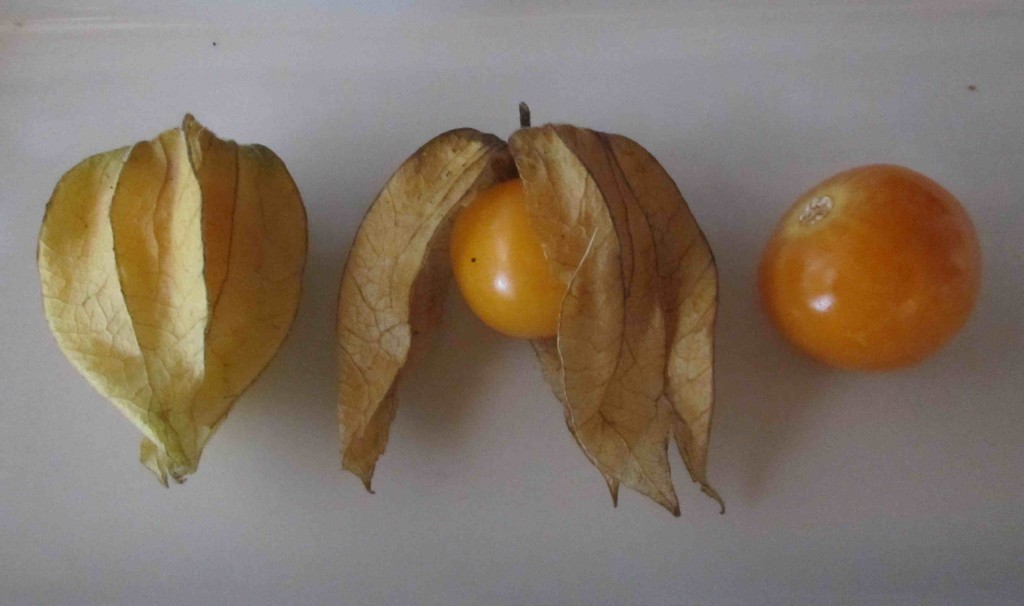
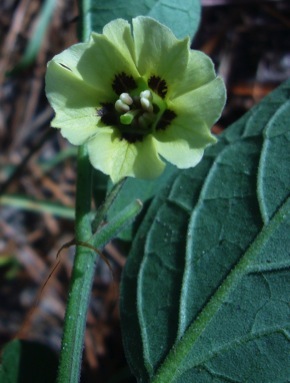
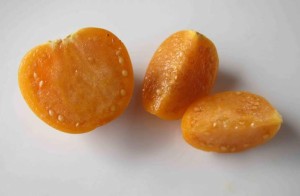
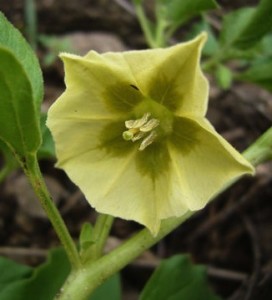
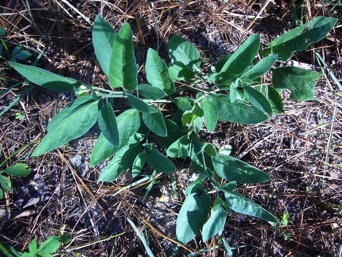
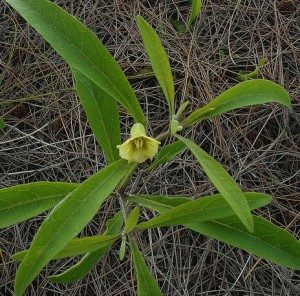
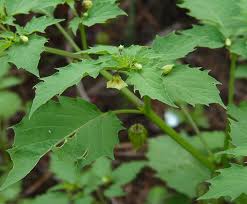

There is a species of physalis here in Kansas (i think its philidelphica or something like that) that has shown promising results at killing various types of cancercells based on some studies and analysis that they are doing with native plants around here. It will be interesting to find out anything comes from it when they do some further testing on it.
P. ANGULATA has also been used for cancer and many other medicinal uses. Not sure which species but one of the PHYSALIS was included in Jimmy Carter’s initial Brain cancer treatment. Basis of that Research was done at Oklahoma university.
I found them growing wild on my 10 acre property.
I found them growing wild on my 1/10 acre property. 🙂
I also have seen them growing on our small acreage, but never knew what they were until today. I always wondered if they were edible, but…
Josh, I am interested in your comment regarding the ground cherry and cancer. I’m also in Kansas, now I have something else to research.
Thanks to eattheweeds for posting this!
Embarrassingly I nearly made a very bad mistake today when I found a Horse Nettle (not sure of any more specific name) and thought it must be some kind of ground cherry. Right family (nightshade) wrong plant 🙁 glad I didn’t actually eat any!
nettles are ok to eat, as long as you arent allergic to them and are careful about the spines.
much like dandelion or other edible wild leafy greens.
can also steam nettles as a tea, the best allergy medicine for me , ever.
just make sure its a nettle and not something else…
Just to clarify Fred’s comment, “horse nettle” and “nettle” are different plants.
I’ve been eating ground cherries and find them to b like candy. So I was excited today when I found these in my horses paddock today. I’ve lived on this property for 25 yrs and never have seen them before however I was weird to try one because the lantern about 2″ in size and skin was bright orange/ red like reminds me of a pumpkin. and skin of lantern was thicker than Ive seen QU. Are these edible. I hope so…. Hope pic goes through
IMG_2123.jpeg
Mr. Deane,
I have an unknown tree / fruit species. The fruit is pear shaped, 5 1/2″ diameter, 5″ tall, thick rind 3/4″ to 1/2′ thick, with dimpled outer surface, yellow to light green surface. The inside was/is sort of pinkish, with large citrus looking seeds.
The leaves are alternate, entire, pinnate w/straight vein branches, primary vein is raised on underside of leaf, elliptical? (my specimens are dried up), attenuate (basicly no petiole), about 5″ long, dark green on top, light green on bottom. The young branches are dark green, becoming light brown w/age. The tree is about 15′ tall, has thorns on young branches and looks like citrus. This is not a regular orange or grapefruit! It is not native to Texas! It is growing in someone’s backyard by the roadway.
Thanks,
Ted Donaho
Is it edible (when not rotten)?
Ted, I don’t know for sure that this is the plant you are dealing with, but check out pomelo (Citrus maxima). It is the principal ancestor of the hybrid we call the grapefruit. The orange (the sweet version, not the bitter orange) was created in Asia more than 2000 years ago by crossing mandarins with pomelos. It wasn’t a simple, one-time thing. Systematic and intentional or not, there was lots of selection for desirable traits, back-crossing with one or the other parent, and so on. The resulting fruit is more mandarin than pomelo, but the maternal line is the pomelo. Jump forward a couple of thousand years, to 17th-Century Barbados, where oranges and pomelos were introduced from China. In the 18th Century, people started talking about a new fruit that had appeared there. Perhaps then, but at least by the early 19th Century, that fruit became what we would recognize as a grapefruit. How much of the early going was accidental and how much might have been intentional is lost to history, but, basically, grapefruit are kind of like most Americans—a New World creation from Old World sources. The pomelo is edible and sweet. On the other hand, like grapefruit, it contains compounds that interact with drug absorption and metabolism. If your doctor has advised you to avoid grapefruit, you should avoid pomelo, too. 🙁
Thanks a million! I learned something new! Thanks again!
Maybe a pawpaw tree?
They grow along creekbanks in N Alabama
Just found one of these plants growing in my town house yard in an Azalea pot. It grew last year and survived the Plymouth winter without dying back and this year is over two feet high and is now covered in lanterns. I was unsure what it was until the flowers and fruit started appearing. I have a variety of Physalis sold by garden centers here in the UK and the plant dies back in winter – it is only a few inches high, the growth takes a very long time to get started with the half a day or so of sun it sees in my walled garden. Attractive plant to me, I wonder how the seed got there!
What color is the ripe “lanterns?” If red the fruit is not edible.
Physalis longifolia is a common lawn weed in Florida. I have them growing all over my garden right now.
The ripe berries are delicious, but leave a bitter aftertaste, so I’ve never swallowed any. I occasionally chew on one, then spit it all out. They taste like a blend of peach and pineapple. I’ve been doing that for decades, hasn’t killed me yet.
Haven’t tried cooking them yet, but this year I’ve got a lot of them. So I’ll probably try it. If the fruit is still bitter after cooking, I’ll toss it out.
Got some seed of Physalis pruinosa from Baker Creek Heirloom Seeds, which I’m growing in containers. The fruit is small, and not as tasty as P. longifolia. But it’s not bitter.
Nothing seems to eat the fruit of P. longifolia, even when it lays on the ground for a while. Could be an important clue there.
I don’t believe that all ground cherries are toxic when young. I read somewhere, I think in one of Samuel Thayer’s books, that there is a type that is located more in the midwest, that does not have hairs on it but is otherwise a ground cherry. The cherries can be eaten green although the taste is sour/bitter and not very pleasant. I know that the plants growing in my yard are of the smooth variety and I have eaten them green and not suffered more than an upset stomach from eating unripe fruits. But the golden/orange colored fruits are best.
Oh, and I’ve kept them over winter although only if you keep them in the husk. I’m not sure why the difference but if you peel them and then keep them, they will not last.
Interesting comments. Never heard of these before this year.
In doing some research for recipes I found this site.
My grandaughter and I built a square foot garden (1 of 4 gardens) and I ordered some seeds, etc. on line, and they sent me a pack of Husk Tomato seeds complimentary. I built a hot bed and planted some of these. They came up late and I thought I was wasting my time. I replanted 4 plants in our sfg 1′ apart and they kicked in high gear. They are now 3′ tall and going wild. Won’t let any weeds grow underneath. Full of ground cherries. Picked up some off the ground and ate them. Delicious. Gathered about 2 dozen off the ground have been eating them. Sent a sandwich bag full home with my son and they love them. Then gathered 3/4 of a big blue coffee can this evening. I will store them for when I come up with a recipe for them. May dehydrate some….
Left a few plants in my hotbed. When I quit tending it, the ground cherries were the last to die off. They are tough.
My wife said her Mother raised them back in the day. Threatened to break their arms if they picked them…lol. We are 60 now. I was looking for a preserve recipe, which I might try, but leaning more to the candied recipes, because it sounds good. Don’t want to mix it to much with other ingredients because I don’t want to take away the attention from the cherry. Read a recipe on chocolate covered.
Going to have to research where the seeds came from because I ordered seeds and plants from several vendors. Will order more seeds next year and take it more serious. Forum says plants will grow from seeds from missed drop berries, but will not take the chance. But will experiment….
Can send pictures of plants if anyone is interested.
Thanks, Denver
Our backyard butts up against a cotton field. After the last flood irrigation tomatillo plants sprung up. They’ve just watered again and the plants are getting big, flowering and putting on fruit.
I know that the wild amaranth that grows along the fields shouldn’t be eaten because it holds in a lot of the nitrates and chemicals from the irrigation. Would the fruits of the tomatillo be ok to eat?
How do you know the are tomatillos?
The husk tomato is a wonderful wild edible. I have found them in many states. In Mexico, they are used to make salsa, although, now that the large version has been cultivated and sold in supermarkets, the wild one is used less. You can easily cultivate a rather large patch of them in just a couple of years…..or just note where they are in the wild around your area. Keep an eye on them in the early fall to see when they blossom; The fruit covered in the papery husk will not be far behind. I harvest mine when they have fallen from the plant. Enjoy yet another of nature’s free foods. No planting. fertilizing or weeding necessary!
I have been growing these for years(Ground Husk Cherry Tomato’s). That is just a better name for them I think. They came from a seed company. Ever since one of my nieces played helper with a packet, I have had a perennial patch in zone 5-6 for 5 years now. Some say they reseed. Although they can if the fruit is left on the ground. They are in fact, for me a die hard plant that survives below zero temps. The standard tomato and tomatillo(Husk Tomato) in addition to the Garden huckleberry will not survive. I have dug up thick root stock that keeps growing wherever I cut it. Aside from picking it is a low maintenance plant. Tilling can spread it to.
Last year I visited a pumpkin patch on Alabama and the field of pumpkins was loaded with ground husk tomatoes. They were lovely, but trampled terribly under foot of the visitors. I let the last who ran the patch know that she had a wonderful supply of husk tomatoes. She was very offended, actually, and said she had been eating husk tomatoes her entire life and those were not husk tomatoes. She was offended, that is, until I showed her your article. They were infact, ground tomatoes. Thank you for your expertise. I’m planning on making chili with the husk tomatoes this year when they are ripe. 🙂
are there any poisonous look-alikes?
Well…. yes… one ornamental variety is toxic and several members of the family are not edible.
I think I have a ground cherry, there is a lantern type husk that turns red with a red marble size fruit inside. It tastes sweet, not bitter, more like a fruit taste. Seeds look more like pepper seeds than tomato. Wish I could attach a picture…
I got some ground cherry fruits that were growing in my sisters yard for years. My brother in law got the seeds from someone not sure where he’s Portuguese and I know in this area a lot of Portuguese people grow them. We had quite a few of them then some became soft so I squished them and worked them into the soil in the pots on my deck, that was late summer last year. Then late summer this year I noticed seedlings growing in the pots but so late in the season. It is now October 9. 2015 and they are all blooming!!! Is this weird or what? I don’t think I’ll get fruit because frost will come soon. Why would they grow so late. Would it be worth it to bring some in to let them grow during the winter and use a paint brush to pollinate them? I live in Raynham, Massachusetts. Thank you!!!
They can put on a fall crop as long as the weather agrees.
I found them in my yard last year. They are delicious. Animals always beat me to them. lol
I’ve been trying to identify ground cherries for a while now. What I find in my area (central VA) look right, but there are no husk, and the leaves have spines. Also they don’t seem to fall off the plant. Am I looking at a ground cherry, or is this something else?
You’ve found Horse Nettle or Tropical Soda Apple, in the same family but not edible.
Sorry. I forgot to mention earlier I live in Massachusetts by cape cod. It’s now September and first I’ve seen them ever in 25 yrs. on same property . Really intrigued to know if my bright red lantern ground tomatoes are edible just want to be cautious since I’m hearing some are not. “Horse nettle” ?
Hi, I have found this plant many times but never eaten it because I was afraid I would have an allergic reaction. I am mildly allergic to tomatoes. Do you think i would be allergic to them?
Hey Mark
I don’t think you would have a problem, They are not a tomato but more a berry, Cape goose berry is what most call them….keep an epy pen handy..lol
found what I thought was ground cherries but the stem is not hairy. It is a square stem like in some mints. leaves are toothed. They have the laterns and the cherry inside. Do I have ground cherry or something else.
Did you find out what you had? I have exactly what you described and I’m trying to figure out what it is, too.
That could be Physalis minima (https://en.wikipedia.org/wiki/Physalis_minima).
Hi please.
This is kalidasan from india. Am grower and supplier of exotic vegetables and herbs. Am looking husk tomato seeds please.
Best regards
kalidasan
Green Deane I have a ground cherry plant that dropped the husk 2 to 3 months ago and never turn color. They stay green. Whats up with that ?
I have had them inside on a window sill facing the sun. Still none ripe, but I have not tasted them.
Green Dean
whats yopur fav ?
how do you think the local variety stands up to
the better cultivars ? (Aunt mollys ground cherry?)
and also against Cape Gooseberry
I think the main different between the wild and cultivated varieties are size (cultivated species tend to be larger) and flavor… wild ground cherries and still occasionally be bitter.
Are the leaves and stems of the ground cherry plants edible? (I’m guessing no, since the husks are listed as inedible) Thank you!
As far as I know only the ripe fruit is edible.
Ground Cherry is in the nightshade family and its leaves in stems contain solanine a poison. Best to avoid eating the greens, but the ripe fruit is fine.
Hi! I have a large patch of these physalis angulata growing from wild in my farm here in Libya. Conflicting reports as to their edibility on the internet. What is the truth plz, as ppl are asking for them, believing them 2 b a cure for many ailments. (I don’t want death to be the final cure for these poor folk.)
The ripe fruit of the P. angulata is edible. But, with wild species you should always try on first to see if it is bitter. Taste one and wait a minute. If it is not bitter it is good to eat. A mild bitter is okay but not a strong bitter taste.
What could be eating my ground cherries? Whatever it is just found them last night. It splits the husk open and eats the berry. The husks aren’t chewed open, as if from a grasshopper or other bug. There’s netting over the bed to keep the chickens and turkeys out, although something could push under the netting. The ground and plants aren’t disturbed at all. I’m hoping the green one it ate gave it a good bellyache!
It is the grocery store of animals…
Glad I came across your site. I have a single physalis plant growing in my backyard. It sprung up after we got some new dirt. I thought it was a wonderful gift but I cannot figure out what type of physalis it is. It is green & does not become yellow or orange. Some of them are a lighter green. I have tried eating a few & they are not tart. It has a sweetish taste & lots of tiny seeds. The fruits are very small; not sure that it’s just this plant & maybe elsewhere they grow slightly larger. It is prolific & I have been picking them for weeks, mostly from the ground. It grew very quickly & has long low branches literally on the ground. It’s fast falling down but still bearing quite a bit. I live in the island of Jamaica, where it’s pretty hot all year round. We’ve had quite a lot of rain this year.
I know this is a long shot as you didn’t mention it in the preparation, but have you or anyone tried dehydrating/ drying out the fruits without the husk? I’m a big fan of a dried orange fruit that I buy at the yellow green farmers market in Hollywood. It has a very tart flavor when dried. They’re orange and about the size of raisins except more rotund once dried. I would love to figure it out so I could grow it. I’m obsessed with the taste and snack on it all the time!
Maybe goji?
Hope you find ground cherries here on Putney Farm when you come to do the Foraging festival on July 13-14, as we have had them growing for years in our garden, but they have been gradually slowly dying out in numbers. We have the heirloom type; Aunt somebody’s pineapple ground cherries. They are delicious; but they get invaded by some kind of worm too often.
At any rate, see you soon in SC!
Yes, dried ones are very good; and you also have the seeds to plant for next year right inside the dried fruit.
Actually, Ripe fruits of P alkakengi, growing in Europe, are edible. I encouraged their growth in my backyard, back when I had one, and also taught my kids to recognize them. Of course, unripe ones are poisonous.
I attended a foraging class this morning at Stanley Lake near Denver, CO.
We found a plant with husk-like fruit. Our instructor could not identify it.
What could it be? I could send you a photo. Thank you.
Yes, GreenDeane@gmail.com
I found them growing in my tiny garden in PA but they stay green. They’re sweet so they seem safe to eat and I’ve eaten lots of them! Hoping they will grow again next year!
I bought some commercial potting soil and guess what… These plants popped up in every pot. I kept pulling them up as weeds. But now I think I’ll let the last one grow and see if I like it.
As a young girl in KS in the 1950’s, I occasionally found these in a vacant field. The leaves were not noticeably hairy & I ate the green sticky fruit with no ill effects – however probably 2-4 at a session, as they were rare, so it was very small amounts. Recently (2020) found some in E. CO in a wild area. The green one I chomped on was somewhat sweet, but having read your caveat re unripe ones, I spit it out. Had no ill effects. Leaves were lanceate with base about 1/2″ wide, grey-green & not hairy. Sherry from the Prairie
I’m gonna try pickling some with ceyan peppers?
Has any done this? And I have wild apricot (Passion Fruit growing crazy in abundance. How do you prepare the fruit?
We found a Physalis ground cherry with black fruits up here in Colorado a few weeks back. I haven’t been able to find it in my guidebook. Do you know of a black-fruited species? Do wild ground cherries tend to have variations of fruit color like that?